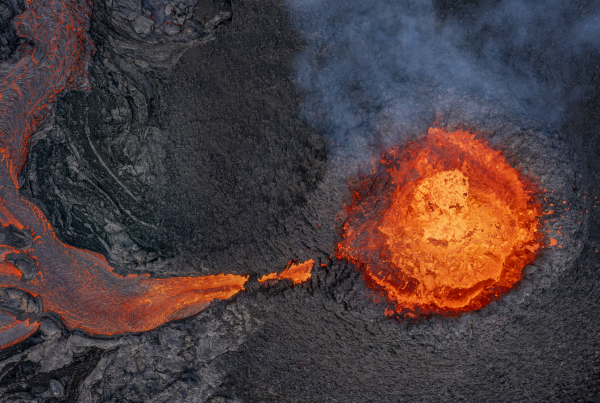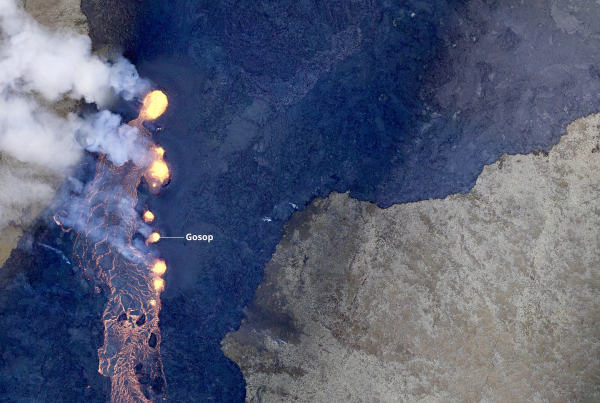
The first sighting of the lava from the eruption close to Fagradalsfjall on the Reykjanes Peninsula. Photo: The Icelandic Met Office
At 16:40 on July 10, a volcanic fissure opened up close to the small mountain Litli-Hrútur in
SW-Iceland. The site is not far from the eruption sites in 2021 and 2022 and is an integral part of a series of volcano-tectonic episodes that began in early 2021 in one out of four volcanic systems (fissure swarms) of the Reykjanes Peninsula.
The eruption is a typical linear eruption with multiple lava basalt fountains and an agile lava
flow that heads to the south in the direction of Meradalir.
The whole prior unrest process, with over 14,000 earthquakes (up til M5.2), has been closely monitored by the Icelandic Met Office and the eruption did not occur unexpectedly.
The fissure might open up some more and the eruption last for weeks or months or, vice versa, it might keep erupting from a central part of the fissure or even stop spouting lava sooner than what seems likely.
-Ari Trausti Guðmundsson
-An amazing video from our friend Ben Hardman
Frequently Asked Questions (FAQ)
Q1: Can I visit the Fagradalsfjall eruption site in person?
A1: Access to the eruption site is subject to local regulations and safety considerations. Currently, the area is closed. In the coming days, designated viewing areas and guided tours will be available to visitors. Please check with local authorities and tour operators for the most up-to-date information on accessibility and safety guidelines. We recommend following Safe Travel Iceland.
Q2: Where can I find information about the Fagradalsfjall eruption?
A2: The Icelandic Met Office (IMO) is a reliable source of information regarding volcanic and seismic activities. They provide regular updates, scientific analyses, and forecasts related to the Fagradalsfjall eruption. Additionally, Lava Centre, an interactive exhibition in Iceland, offers valuable insights and educational resources about volcanic eruptions, including the Fagradalsfjall eruption. Visit Lava Centre’s exhibition or their official website for comprehensive information. Finally, for updates on safety and accessibility, we recommend Safe Travel Iceland
Q3: How long is the Fagradalsfjall eruption expected to last?
A3: The duration of volcanic eruptions can vary significantly. While it is challenging to predict with absolute certainty, experts estimate that the Fagradalsfjall eruption may continue for weeks, months, or even longer. Ongoing monitoring and scientific analysis by the Icelandic Met Office contribute to our understanding of the eruption’s progression.
Q4: Are there any safety measures in place for visitors interested in witnessing the eruption up close?
A4: Safety is a top priority, and visitors are encouraged to follow the guidance of local authorities and adhere to designated viewing areas. It is important to respect the volcanic landscape and stay informed about any potential hazards. Tour operators offering guided excursions prioritize safety protocols to ensure a memorable and secure experience. The hike to the eruption site is long and over very difficult terrain. So please check with the authorities, be dressed for a cold long day, bring food and water or take a safer alternative with a guided tour.
Q5: How can I stay informed about the Fagradalsfjall eruption if I cannot visit Iceland?
A5: If you cannot witness the eruption in person, you can stay connected through the live web cameras provided in a previous blog post. Additionally, regularly check the Icelandic Met Office’s official website and social media channels for updates, as they offer real-time information and scientific insights about the eruption. And finally, LAVA Centre’s twitter channel is always quite active and a good source for geologists and content creators of interest.



